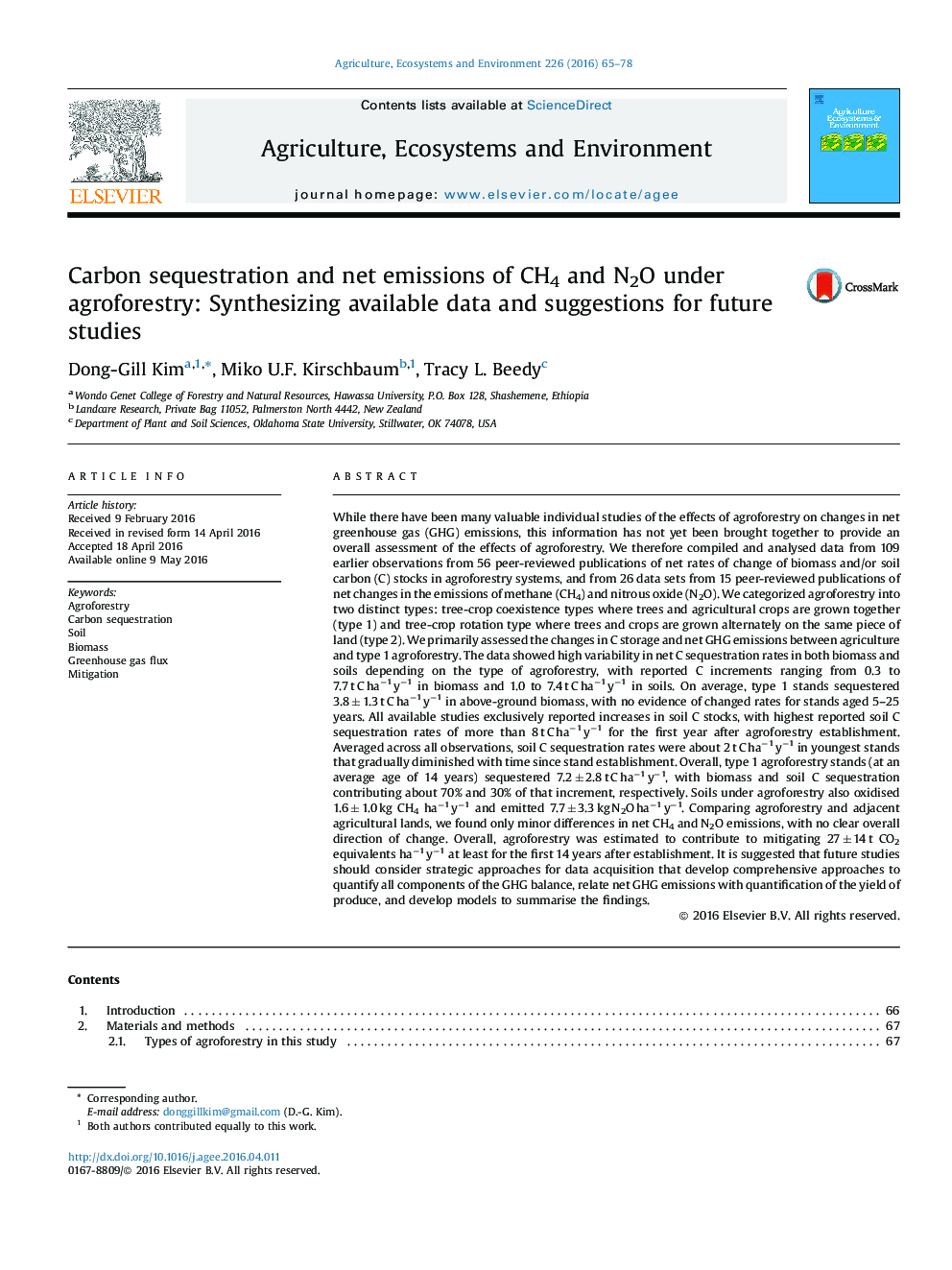| کد مقاله | کد نشریه | سال انتشار | مقاله انگلیسی | نسخه تمام متن |
|---|---|---|---|---|
| 2413515 | 1552026 | 2016 | 14 صفحه PDF | دانلود رایگان |

• We summarized carbon sequestration and net emissions of CH4 and N2O under agroforestry.
• Agroforestry stands sequestered 7.2 ± 2.8 t C ha−1 y−1 (70% in biomass and 30% in soil).
• Soils under agroforestry oxidised 1.6 kg CH4 ha−1 y−1 and emitted 7.7 kg N2O ha−1 y−1.
• Agroforestry was estimated to mitigate 27 ± 14 t CO2 equivalent ha−1 y−1.
While there have been many valuable individual studies of the effects of agroforestry on changes in net greenhouse gas (GHG) emissions, this information has not yet been brought together to provide an overall assessment of the effects of agroforestry. We therefore compiled and analysed data from 109 earlier observations from 56 peer-reviewed publications of net rates of change of biomass and/or soil carbon (C) stocks in agroforestry systems, and from 26 data sets from 15 peer-reviewed publications of net changes in the emissions of methane (CH4) and nitrous oxide (N2O). We categorized agroforestry into two distinct types: tree-crop coexistence types where trees and agricultural crops are grown together (type 1) and tree-crop rotation type where trees and crops are grown alternately on the same piece of land (type 2). We primarily assessed the changes in C storage and net GHG emissions between agriculture and type 1 agroforestry. The data showed high variability in net C sequestration rates in both biomass and soils depending on the type of agroforestry, with reported C increments ranging from 0.3 to 7.7 t C ha−1 y−1 in biomass and 1.0 to 7.4 t C ha−1 y−1 in soils. On average, type 1 stands sequestered 3.8 ± 1.3 t C ha−1 y−1 in above-ground biomass, with no evidence of changed rates for stands aged 5–25 years. All available studies exclusively reported increases in soil C stocks, with highest reported soil C sequestration rates of more than 8 t C ha−1 y−1 for the first year after agroforestry establishment. Averaged across all observations, soil C sequestration rates were about 2 t C ha−1 y−1 in youngest stands that gradually diminished with time since stand establishment. Overall, type 1 agroforestry stands (at an average age of 14 years) sequestered 7.2 ± 2.8 t C ha−1 y−1, with biomass and soil C sequestration contributing about 70% and 30% of that increment, respectively. Soils under agroforestry also oxidised 1.6 ± 1.0 kg CH4 ha−1 y−1 and emitted 7.7 ± 3.3 kg N2O ha−1 y−1. Comparing agroforestry and adjacent agricultural lands, we found only minor differences in net CH4 and N2O emissions, with no clear overall direction of change. Overall, agroforestry was estimated to contribute to mitigating 27 ± 14 t CO2 equivalents ha−1 y−1 at least for the first 14 years after establishment. It is suggested that future studies should consider strategic approaches for data acquisition that develop comprehensive approaches to quantify all components of the GHG balance, relate net GHG emissions with quantification of the yield of produce, and develop models to summarise the findings.
Figure optionsDownload as PowerPoint slide
Journal: Agriculture, Ecosystems & Environment - Volume 226, 16 June 2016, Pages 65–78